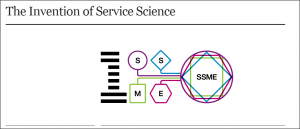Using convergent interviewing was an interesting experience. I had not used the technique before except as part of a short pilot of the project. The technique was selected because it was determined to be sympathetic to the principle of Actor-Network Theory whereby the researcher should have no a priori views of the situation in question, the technique starts with one very open ended question with following questions being directly derived from the answers that the participants provide. There is very little in the way of interviention on the part of the researcher.
The other reason is the technique was sympathetic to the organisation that the research was carried out in. Staff were selected on the basis of their role with subsequent participants selected by other participants which was seen as a democratic way of selecting participants.
The process as described by Dick recommends that Convergent Interviewing is carried out by two viewers, one who asks the question and the other takes notes. Obviously I was not able to work in collaboration so had to ask the question and take notes myself.
Dick also recommends taking hand written notes and no more than a side of paper. Subsequent researchers have used voice recording though and to be thorough I decide do to use voice recording and then transcribe the interviews. I did take notes during the interviews.
At the beginning of the interview process I found it quite difficult to decide when to change the initial question because it seemed to generate a lot of interesting data.
It was pretty difficult to decide when to change the question but I managed to do so. After this is was easier to decide when to change the question. Basically, I changed the question whenever there was a significant change in the type of role a participant was in.
Participants found Convergent Interviewing interesting. Most people we a little confused by there being only one main question and were skeptical when I told them that they should speak of up to an hour without any other major questions or prompts.
What was interesting was that once the participants got going they all found it easy to keep talking without the need for further questions and only minimal prompts.
For the interviews I had typed and printed the main question on a piece of paper and included four or five issues that the participant might want to talk about although they did not have to and some didn’t.
For the majority of participants I found that I did not need to provide any prompts because after some initial thoughts people found it easy to talk about their job role and the history of the organisation as far as they knew it.
I asked each participant whether they agreed to have the interview recorded and they all did.
After each interview I reviewed my notes and the questions and made some decisions about the next question. I asked each participant to recommend the next participant, so the process was built around snowballing in terms of participant selection.
The main issue with Convergent Interviewing seems to be the amount of time that it takes to analyse the data and the open ended nature of the questions can lead to a lot of divergent data.
I would like to use the technique again and with more inteviewers, as described by Dick. The technique seems to be often used where there is feeling that something interesting is happening but there is no clarity. The process can be used to clarify issues and help focus attention on critical issues for later follow up.


![[Book] The Research Journey](https://yellowbag.edublogs.org/files/2013/08/Snap-2013-08-27-at-11.22.49-10qioj4-200x300.png)